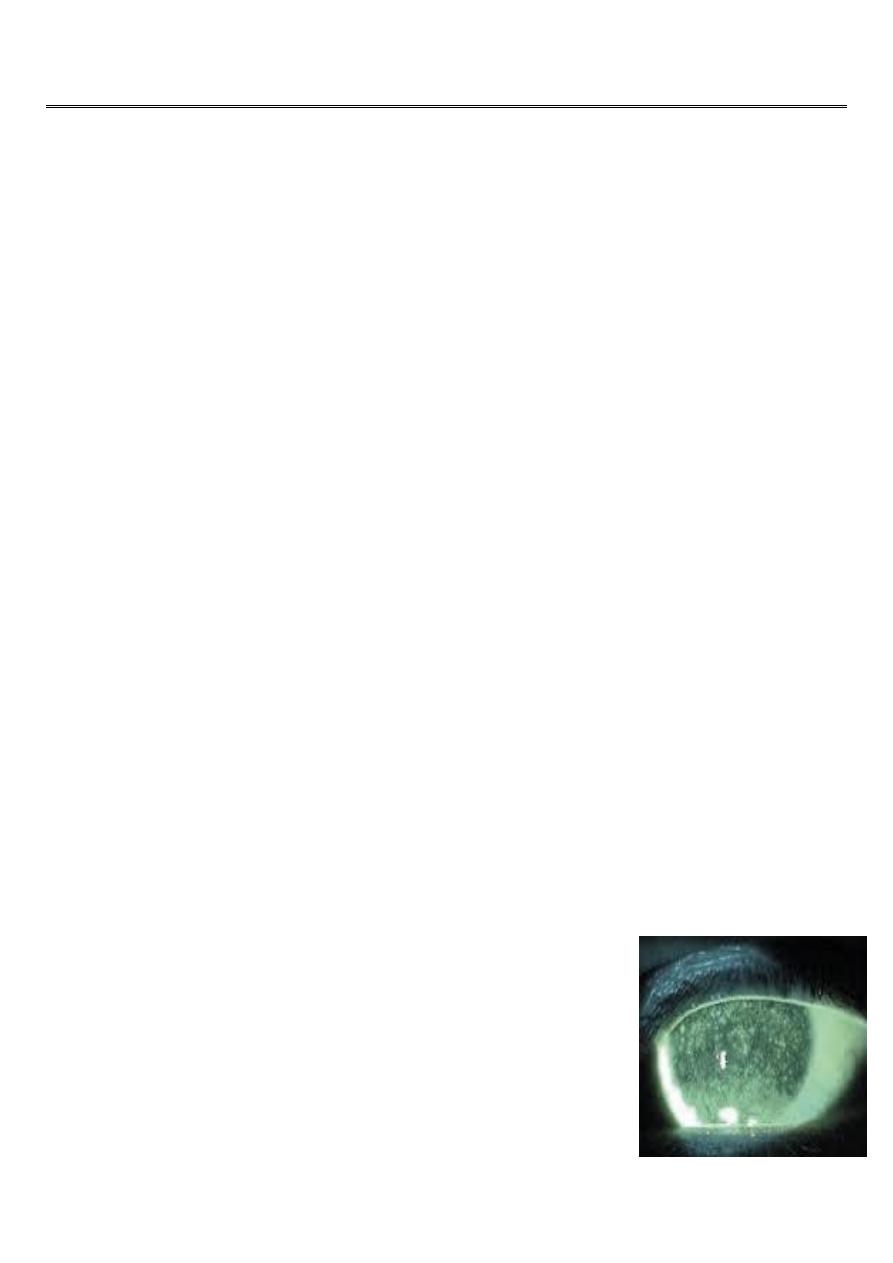
1
Fifth stage
Ophthalmology
Lec-1
د ذاكر
2015/11/22
The lacrimal system
The lacrimal glands normally produce about 1.2 µl of tears per minute .Some are lost via
evaporation .The remains are drained via the naso-lacrimal system .The tear film is
re-formed with every blink.
Abnormalities are found in:
• tear composition;
• the drainage of tears.
ABNORMALITIES IN COMPOSITION
If certain components of the tear film are deficient or there is a disorder of eyelid
apposition then there can be a disorder of ocular wetting.
Aqueous insufficiency—dry eye
keratoconjunctivitis sicca (KCS) or dry eyes
With dry mouth and other mucous membranes primary Sjögren’s syndrome
( an auto-
immune exocrinopathy.
With auto-immune connective tissue disorder (Rheumatoid arthritis) secondary
Sjögren’s syndrome .
SYMPTOMS
burning ,photophobia ,
heaviness of the lids and ocular fatigue .worse in the evening
.
visual acuity may be reduced by corneal damage.
SIGNS
punctate
staining )over the exposed corneal and conjunctival
surface .
(
In severe cases tags of abnormal mucus may attach to the
corneal surface
( filamentary
keratitis )causing pain due to
tugging on these filaments during blinking

2
TREATMENT
tear substitutes
shielded spectacles.
severe cases it may be necessary to occlude the punta with plugs, or more
permanently with surgery, to conserve the tears.
PROGNOSIS
Mild disease usually responds to artificial tears. Severe disease such as that in
rheumatoid Sjögren’s can be very difficult to treat.
Inadequate mucus production
Destruction of the goblet cells as in dry eye
cicatricial conjunctival disorders e.g. erythema multi -
forme (Stevens–Johnson’s
syndrome)
Chemical burns of the eye, particularly by alkalis
trachoma.
Vitamin A deficiency (xerophthalmia. Goblet cells are lost from the conjunctiva and
the ocular surface becomes keratinized (xerosis).
Abnormal or inadequate production of meibomian oil
Absence of the oil layer causes tear film instability ,associated with blepharitis
Malposition of the eyelid margins
If the lid is not apposed to the eye
( ectropion ,)or there is insufficient closure of the eyes
e.g .in a seventh nerve palsy or if the eye protrudes (proptosis) as in dysthyroid eye
disease.
LATERAL TARSORRHAPHY
DISORDERS OF TEAR DRAINAGE
When tear production exceeds the capacity of the drainage system ,excess tears overflow
onto the cheeks .It may be caused by:
• irritation of the ocular surface ,e.g .by a corneal foreign body ,infection or
blepharitis;
• occlusion of any part of the drainage system (when the tearing is termed epiphora)

3
Obstruction of tear drainage (infant)
The distal end of the naso-lacrimal duct may remain imperforate ,causing a
watering eye .
mucocoele
dacrocystitis .
Diagnostically the discharge may be expressed from the puncta by pressure over
the lacrimal sac .The conjunctiva ,however ,is not inflamed .
Most obstructions resolve spontaneously in the first year of life
probing via the punctum through the naso-lacrimal duct to perforate the occluding
membrane (probing). A general anaesthetic is required.
Obstruction of tear drainage (adult)
the most common site is the naso-lacrim al duct .
Causes include infection or direct trauma to the naso-lacrimal system.
HISTORY
watering eye sometimes associated with stickiness .The eye is white .
Symptoms may be worse in the wind or in cold weather .There may be a history of
previous trauma or infection.
SIGNS
A stenosed punctum may be apparent on slit lamp examination .Epiphora is
unusual if one punctum continues to drain .Acquired obstruction
syringing the naso-lacrimal system.
The exact location of the obstruction can be confirmed by injecting a radio-opaque
dye into the naso-lacrimal system
( dacrocystogram ;)X-rays are then used to follow
the passage of the dye through the system.
TREATMENT
dacryocystorrhinostomy
or
DCR
The operation can be performed through an
incision on the side of the nose but it may also be performed endoscopically
through the nasal passages thus avoiding a scar on the face.
